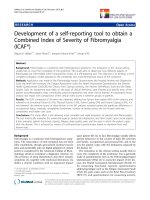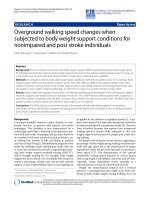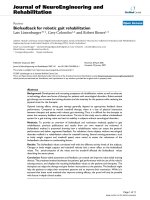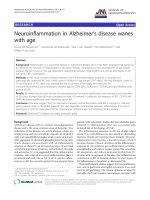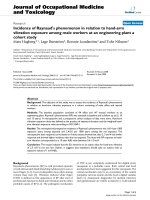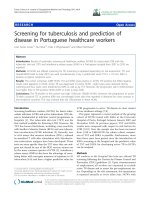Báo cáo hóa học: " Inequalities for Green’s operator applied to the minimizers" doc
Bạn đang xem bản rút gọn của tài liệu. Xem và tải ngay bản đầy đủ của tài liệu tại đây (292.89 KB, 10 trang )
RESEARC H Open Access
Inequalities for Green’s operator applied to the
minimizers
Ravi P Agarwal
1
and Shusen Ding
2*
* Correspondence: sding@seattleu.
edu
2
Department of Mathematics,
Seattle University, Seattle, WA
98122, USA
Full list of author information is
available at the end of the article
Abstract
In this paper, we prove both the local and global L
-norm inequalities for Green’s
operator applied to minimizers for functionals defined on differential forms in
L
-averaging domains. Ou r results are extensions of L
p
norm inequalities for Green’s
operator and can be used to estimate the norms of other operators applied to
differential forms.
2000 Mathematics Subject Classification: Primary: 35J60; Secondary 31B05, 58A10,
46E35.
Keywords: Green’s operator, minimizers, inequalities and differential forms
1. Introduction
Let Ω be a bounded domain in ℝ
n
, n ≥ 2, B and s B with s > 0 be the balls with the
same center and diam(s B)=sdiam(B) throughout this paper. The n-dimensional
Lebesgue measure of a set E ⊆ ℝ
n
is expressed by |E|. For any function u,wedenote
the average of u over B by
u
B
=
1
|
B
|
B
ud
x
.Allintegralsinvolvedinthispaperarethe
Lebesgue integrals.
A differential 1-form u(x)inℝ
n
can be written as
u
(x)=
n
i
=1
u
i
(x
1
, x
2
, ··· , x
n
)dx
i
,
where the coefficient functions u
i
(x
1
, x
2
, , x
n
), i = 1, 2, , n, are differentiable. Similarly,
a differential k-form u(x) can be denoted as
u(x)=
I
u
I
(x)dx
I
=
u
i
1
i
2
···i
k
(x)dx
i
1
∧ dx
i
2
∧···∧dx
i
k
,
where I =(i
1
, i
2
, , i
k
), 1 ≤ i
1
<i
2
< <i
k
≤ n. See [1-5] for more properties and some
recent results about differential forms. Let ∧
l
= ∧
l
(ℝ
n
)bethesetofalll-forms in ℝ
n
,
D’ (Ω, ∧
l
) be the space of all differential l-forms in Ω,andL
p
(Ω, ∧
l
)betheBanach
space of all l-forms u(x)=Σ
I
u
I
(x)dx
I
in Ω satisfying
u
p,E
=
E
|u(x)|
p
dx
1/p
=
⎛
⎝
E
I
|u
I
(x)|
2
p/2
dx
⎞
⎠
1
/
p
for all ordered l-tuples I, l = 1, 2, , n. It is easy to see that the space ∧
l
is of a basis
{dx
i
1
∧ dx
i
2
∧···∧dx
i
l
,1≤ i
1
< i
2
< ··· < i
l
≤ n}
,
Agarwal and Ding Journal of Inequalities and Applications 2011, 2011:66
/>© 2011 Agarwal and Ding; licensee Springer. This is an Open Access article distributed under the terms of the Creative Commons
Attribution License (http://creativecommons .org/licenses/by/2.0), which permits unrestricted use, distribution, and repro duction in
any medium, provided the original work is properly cited.
and hence
dim(∧
l
)=dim(∧
l
(R
n
)) =
n
l
and
dim(∧)=
n
l
=
0
dim(∧
l
(R
n
)) =
n
l
=
0
n
l
=2
n
.
We denote the exterior derivative by d : D’(Ω, ∧
l
) ® D’(Ω, ∧
l+1
) for l = 0, 1, , n -1.
The exterior differential can be calculated as follows
dω(x)=
n
k=1
1≤i
1
<···<i
l
≤n
∂ω
i
1
i
2
···i
l
(x)
∂x
k
dx
k
∧ dx
i
1
∧ dx
i
2
∧···∧dx
i
l
.
Its for mal adjoi nt operator d
⋆
which is called the H odge codifferential is defined by
d
⋆
=(-1)
nl+1
⋆ d⋆: D’(Ω, ∧
l+1
) ® D’(Ω, ∧
l
), where l = 0, 1, , n -1,and⋆ is the well
known Hodge star operator. We say that
u
∈ L
1
loc
(∧
l
)
has a g eneralized gradient if,
for each coordinate system, the pullbacks of the coordinate function of u have general-
ized gradient in the familiar sense, see [6]. We write
W
(
∧
l
)
={
u
∈ L
1
loc
(∧
l
)
: u has
generalized gradient}. As usual, the harmonic l-fields are defined by
H
(
∧
l
)
= {u ∈ W
(
∧
l
)
: du = d
u =0,u ∈ L
p
for some 1 < p < ∞
}
, The orthogonal
complement of
H
in L
1
is defined by
H
⊥
=
{
u ∈ L
1
:< u, h >=0forallh ∈ H
}
.Greens’
operator G is defined as
G : C
∞
(
∧
l
)
→ H
⊥
∩ C
∞
(
∧
l
)
by assigning G(u)bethe
unique element of
H
⊥
∩ C
∞
(
∧
l
)
satisfying Poisson’sequationΔG(u)=u - H(u ),
where H is either the harmonic projection or sometimes the harmonic part of u and Δ
is the Laplace-Beltrami operator, see [2,7-11] for more properties of Green’soperator.
In this paper, we alway use G to denote Green’s operator.
2. Local inequalities
The purpose of this paper is to establish the L
-norm inequalities for Green’s operator
applied to the following k-quasi-minimizer. We say a differential form
u
∈ W
1
,
1
loc
(,
)
is a k-quasi-minimizer for the functional
I(; v)=
(|dv|)d
x
(2:1)
if and only if, for every
ϕ ∈ W
1
,
1
loc
(,
)
with compact support,
I
(
supp ϕ; u
)
≤ k · I
(
supp ϕ; u + ϕ
),
where k > 1 is a constant. We say that satisfies the so called Δ
2
-condition if there
exists a constant p > 1 such that
ϕ
(
2t
)
≤ pϕ
(
t
)
(2:2)
for all t > 0, from which it follows that (lt) ≤ l
p
(t)foranyt >0andl ≥ 1, see
[12].
We will need the following lemma which can be found in [13] or [12].
Lemma 2.1. Let f(t) be a nonnegative f unction defined on the interval [a, b] with a ≥
0. Suppose that for s, t Î [a, b] with t <s,
Agarwal and Ding Journal of Inequalities and Applications 2011, 2011:66
/>Page 2 of 10
f (t) ≤
M
(
s − t
)
α
+ N + θf (s
)
holds, where M, N, a and θ are nonnegative constants with θ <1.Then, there exists a
constant C = C(a, θ ) such that
f (ρ) ≤ C
M
(
R − ρ
)
α
+ N
for any r, R Î [a, b] with r <R.
A continuously increasing function :[0,∞) ® [0, ∞)with (0) = 0, is called an
Orlicz function.
The Orlicz space L
(Ω) consists of all measurable functions f on Ω such that
ϕ
|f |
λ
dx <
∞
for some l = l(f) >0. L
(Ω) is e quipped with the nonlinear Luxem-
burg functional
f
ϕ()
= inf {λ>0:
ϕ
|f |
λ
dx ≤ 1}
.
A convex Orlicz function is often called a Young function. A special useful Young
function :[0,∞) ® [0, ∞), termed an N-function, is a continuous Young function
such that (x)=0ifandonlyifx = 0 and lim
x ® 0
(x)/x =0,lim
x ® ∞
(x)/x =+∞.
If is a Young function, then || · ||
defines a norm in L
(Ω), which is called the Lux-
emburg norm.
Definition 2.2[14]. We say a Young function lies in the class G(p, q, C), 1 ≤ p
<q < ∞, C ≥ 1, if (i) 1/C ≤ (t
1/p
)/F(t) ≤ C and (ii) 1/C ≤ (t
1/q
)/Ψ (t) ≤ C for all t
>0,whereF is a convex increasing function and Ψ is a concave increasing function
on [0, ∞).
From [14], each of , F and Ψ in above definition is doubling in the sense that its
values at t and 2t are uniformly comparable for all t > 0, and the consequent fact that
C
1
t
q
≤
−1
(
ϕ
(
t
))
≤ C
2
t
q
, C
1
t
p
≤
−1
(
ϕ
(
t
))
≤ C
2
t
p
,
(2:3)
where C
1
and C
2
are constants. It is easy to see that Î G(p, q, C) satisfies the Δ
2
-
condition. Also , for all 1 ≤ p
1
<p <p
2
and a Î ℝ, the function
ϕ(t)=t
p
log
α
+
t
belongs to
G(p
1
, p
2
, C) for some constant C = C(p, a, p
1
, p
2
). Here log
+
(t) is defined by log
+
(t)=1
for t ≤ e; and log
+
(t)=log(t) for t>e. Particularly, if a = 0, we see that (t)=t
p
lies in
G(p
1
, p
2
, C), 1 ≤ p
1
<p <p
2
.
Theorem 2.3. Let
u ∈ W
1,1
loc
(,
)
be a k-quasi-minimizer for the functional (2.1),
be a Young function in the class G(p, q, C), 1 ≤ p <q < ∞, C ≥ 1 and q(n-p)<np, Ω
be a bounded domain and G be Green’s operator. Then, there exists a constant C, inde-
pendent of u, such that
B
ϕ(|G(u) − (G(u))
B
|)dx ≤ C
2B
ϕ(|u − c|)dx
(2:4)
for all balls B = B
r
with radius r and 2B ⊂ Ω, where c is any closed form.
Proof. Using Jensen’s inequality for Ψ
-1
,(2.3),andnoticingthat and Ψ are dou-
bling, for any ball B = B
r
⊂ Ω, we obtain
Agarwal and Ding Journal of Inequalities and Applications 2011, 2011:66
/>Page 3 of 10
B
ϕ
|G(u) − (G(u))
B
|
dx =
−1
B
ϕ(|G(u) − (G(u))
B
|)dx
≤
B
−1
ϕ(|G(u) − (G(u))
B
|)
dx
≤
C
1
B
|G(u) − (G(u))
B
|
q
dx
≤ C
2
ϕ
C
1
B
|G(u) − (G(u))
B
|
q
dx
1/q
≤ C
3
ϕ
B
|G(u) − (G(u))
B
|
q
dx
1/q
.
(2:5)
Using the Poincaré-type inequality for differential forms G(u) and noticing that
G(u)
p
,B
≤ C
4
||u||
p
,
B
holds for any differential form u, we obtain
B
|G(u) − (G(u))
B
|
np/(n−p)
dx
(n−p)/n
p
≤ C
5
B
|d(G(u))|
p
dx
1/p
≤ C
5
B
|G(du)|
p
dx
1/p
≤ C
6
B
|du|
p
dx
1/p
.
(2:6)
If 1 <p <n, by assumption, we have
q <
np
n−
p
. Then,
B
|G(u) − (G(u))
B
|
q
dx
1/q
≤ C
7
B
|du|
p
dx
1/p
.
(2:7)
Note that the L
p
-norm of |G(u)-(G(u))
B
|increaseswithp and
np
n−
p
→
∞
as p ® n,
it follows that (2.7) still holds when p ≥ n.Since is increasing, from (2.5) and (2.7),
we obtain
B
ϕ
|G(u) − (G(u))
B
|
dx ≤ C
3
ϕ
C
7
B
|du|
p
dx
1/p
.
(2:8)
Applying (2.8), (i) in Definition 2.2, Jensen’s inequality, and noticing that and F are
doubling, we have
B
ϕ
|G(u) − (G(u))
B
|
dx ≤ C
3
ϕ
C
7
B
|du|
p
dx
1/p
≤ C
3
C
8
B
|du|
p
dx
≤ C
9
B
(|du|
p
)dx.
(2:9)
Agarwal and Ding Journal of Inequalities and Applications 2011, 2011:66
/>Page 4 of 10
Using (i) in Definition 1.1 again yields
B
(|du|
p
)dx ≤ C
10
B
ϕ(|du|)dx
.
(2:10)
Combining (2.9) and (2.10), we obtain
B
ϕ
|G(u) − (G(u))
B
|
dx ≤ C
11
B
ϕ(|du|)d
x
(2:11)
for any ball B ⊂ Ω. Next, let B
2r
= B(x
0
,2r) be a ball with radius 2r and center x
0
, r
<t <s <2r. Set h(x)=g(|x - x
0
|), where
g
(τ )=
⎧
⎨
⎩
1, 0 ≤ τ ≤
t
affine, τ<t < s
0, τ ≥ s.
Then,
η ∈ W
1,∞
0
(B
s
)
, h (x)=1onB
t
and
|
dη(x)| =
(s − t)
−
1
, t ≤|x − x
0
|≤
s
0, otherwise.
(2:12)
Let v(x)=u(x)+(h(x))
p
(c-u(x)), where c is any closed form. We find that
dv =(1− η
p
)du + η
p
p
dη
η
(c − u(x))
.
(2:13)
Since ψ is an increasing convex function satisfying the Δ
2
-condition, we obtain
ϕ(|dv|) ≤ (1 − η
p
)ϕ(|du|)+η
p
ϕ(p
|dη|
η
|c − u(x)|)
.
(2:14)
Using the definition of the k-quasi-minimizer and (2.2), it follows that
B
s
ϕ(|du|)dx ≤ k
B
s
ϕ(|dv|)dx
≤ k
B
s
\B
t
(1 − η
p
)ϕ(|du|)dx +
B
s
η
p
ϕ
p
|dη|
η
|c − u(x)|
dx
≤ k
B
s
\
B
t
ϕ(|du|)dx + p
p
B
s
ϕ (|dη||u − c|)dx
.
(2:15)
Applying (2.15), (2.12)) and (2.3), we have
B
t
ϕ(|du|)dx ≤
B
s
ϕ(|du|)dx
≤ k
B
s
\B
t
ϕ(|du|)dx + p
p
B
s
ϕ
4r
|u − c|
(s − t)2r
dx
≤ k
B
s
\
B
t
ϕ(|du|)dx +
(4pr)
p
(s − t)
p
B
s
ϕ
|u − c|
2r
dx
.
(2:16)
Adding
k
B
t
ϕ(|du|)d
x
to both sides of inequality (2.16) yields
B
t
ϕ(|du|)dx ≤
k
k +1
B
s
ϕ(|du|)dx +
(4pr)
p
(s − t)
p
B
s
ϕ
|u − c|
2r
dx
.
(2:17)
Agarwal and Ding Journal of Inequalities and Applications 2011, 2011:66
/>Page 5 of 10
In order to use Lemma 2.1, we write
f (t)=
B
t
ϕ(|du|)dx, f (s)=
B
s
ϕ(|du|)dx, M =(4pr)
p
B
s
ϕ
|u − c|
2r
d
x
and N = 0. From (2.17), we find that the conditions of Lemma 2.1 are satisfied.
Hence, using Lemma 2.1 with r = r and a = p, we obtain
B
r
ϕ(|du|)dx ≤ C
12
B
2
r
ϕ
|u − c|
2r
dx
,
(2:18)
Note that is doubling, B = B
r
and 2B = B
2r
. Then, (3.18) can be written as
B
ϕ(|du|)dx ≤ C
13
2B
ϕ (|u − c|)dx
.
(2:19)
Combining (2.11) and (2.19) yields
B
ϕ
|G(u) − (G(u))
B
|
dx ≤ C
14
2B
ϕ (|u − c|)dx
.
(2:20)
The proof of Theorem 2.3 has been completed. □
Since each o f , F and Ψ in Definition 2.2 is doubling, from the proof of Theorem
2.3 or directly from (2.3), we have
B
ϕ
|G(u) − (G(u))
B
|
λ
dx ≤ C
2B
ϕ
|u − c|
λ
d
x
(2:21)
for all balls B with 2B ⊂ Ω and any constant l > 0. From d efinition of the Luxem-
burg norm and (2.21), the following inequality with the Luxemburg norm
G(u) − (G(u))
B
ϕ
(
B
)
≤ C u − c
ϕ
(
2B
)
(2:22)
holds under the conditions described in Theorem 2.3.
Note that in Theorem 2.3, c is any closed form. Hence, we may choose c = 0 in The-
orem 2.3 and obtain the following version of -norm inequality which may be conveni-
ent to be used.
Corol lary 2.4. Let
u
∈ W
1,1
loc
(,
)
be a k-quasi-minimizer for the functional (2.1),
be a Young function in the class G(p, q, C), 1 ≤ p <q < ∞, C ≥ 1 and q(n-p)<np, Ω
be a bounded domain and G be Green’s operator. Then, there exists a constant C, inde-
pendent of u, such that
B
ϕ(|G(u) − (G(u))
B
|)dx ≤ C
2B
ϕ (|u|)d
x
(2:23)
for all balls B = B
r
with radius r and 2B ⊂ Ω.
3. Global inequalities
In this section, we extend the local Poincar é type inequalities into the global cases in
the following L
-averaging domains, which are extension of John domains and L
s
-aver-
aging domain, see [15,16].
Definition 3.1[16]. Let be an increasing convex function on [0, ∞)with(0) = 0.
We call a proper subdomain Ω ⊂ ℝ
n
an L
-averaging domain, if |Ω| < ∞ and there
Agarwal and Ding Journal of Inequalities and Applications 2011, 2011:66
/>Page 6 of 10
exists a constant C such that
ϕ(τ |u − u
B
0
|)dx ≤ Csup
B
⊂
B
ϕ(σ |u − u
B
|)d
x
(3:1)
for some b all B
0
⊂ Ω and all u such that
ϕ(|u|) ∈ L
1
loc
(
)
,whereτ, s are constants
with 0 <τ < ∞,0<s < ∞ and the supremum is over all balls B ⊂ Ω.
From above definition we see that L
s
-averaging domains and L
s
(μ)-averaging domains
are special L
-averaging domains when (t)=t
s
in Definition 3.1. Also, uniform
domains and John domains are very special L
-averaging domains, see [1,15,16] for
more results about domains.
Theorem 3.2. Let
u ∈ W
1
,
1
loc
(,
0
)
be a k-quasi-minimizer for the functional (2.1),
be a Young function in the class G(p, q, C), 1 ≤ p <q < ∞, C ≥ 1 and q(n-p)<np, Ω
be any bounded L
-averaging domain and G be Green’soperator. Then, there exists a
constant C, independent of u, such that
ϕ(|G(u) − (G(u))
B
0
|)dx ≤ C
ϕ (|u − c|)dx
,
(3:2)
where B
0
⊂ Ω is some fixed ball and c is any closed form.
Proof. From Definition 3.1, (2.4) and noticing that is doubling, we have
ϕ(|G(u) − (G(u))
B
0
|)dx ≤ C
1
sup
B⊂
B
ϕ(|G(u) − (G(u))
B
|)d
x
≤ C
1
sup
B⊂
C
2
2B
ϕ(|u − c|)dx
≤ C
1
sup
B⊂
C
2
ϕ(|u − c|)dx
≤ C
3
ϕ(|u − c|)dx.
We have completed the proof of Theorem 3.2. □
Similar to the local inequality, the following global inequality with the Orlicz norm
G(u) − (G(u))
B
0
ϕ
(
)
≤ C u
ϕ
(
)
(3:3)
holds if all conditions in Theorem 3.2 are satisfied.
We know that any John domain is a special L
-averaging domain. Hence, we have
the following inequality in John domain.
Theorem 3.3. Let
u
∈ W
1,1
loc
(,
0
)
be a k-quasi-minimizer for the functional (2.1),
be a Young function in the class G(p, q, C), 1 ≤ p <q < ∞, C ≥ 1 and q(n-p)<np, Ω
be any bounded John domain and G be Green’soperator. Then, there exists a constant
C, independent of u, such that
ϕ(|G(u) − (G(u))
B
0
|)dx ≤ C
ϕ (|u − c|)dx
,
(3:4)
where B
0
⊂ Ω is some fixed ball and c is any closed form.
Choosing
ϕ(t)=t
p
log
α
+
t
in Theorems 3.2, we obtain the following inequalities with
the
L
p
(log
α
+
L
)
-norms.
Corollary 3.4. Let
u
∈ W
1
,
1
loc
(,
0
)
be a k-quasi-minimizer for the functional (2.1),
ϕ(t)=t
p
log
α
+
t
, a Î ℝ, q(n-p)<np for 1 ≤ p <q < ∞ and G be Green’soperator. Then,
Agarwal and Ding Journal of Inequalities and Applications 2011, 2011:66
/>Page 7 of 10
there exists a constant C, independent of u, such that
|G(u) − (G(u))
B
0
|
p
log
α
+
(|G(u) − (G(u))
B
0
|)dx ≤ C
|u − c|
p
log
α
+
(|u − c|)d
x
(3:5)
for any bounde d L
-averaging domain Ω, where B
0
⊂ Ω is some fixed ball and c is
any closed form.
We can also write (3.5) as the following inequality with the Luxemburg norm
G(u) − (G(u))
B
0
L
p
(log
α
+
L)()
≤ C u − c
L
p
(log
α
+
L)(
)
(3:6)
provided the conditions in Corollary 3.5 are satisfied.
Similar to the local case, we may choose c = 0 in Theo rem 3.2 and obtain he follow-
ing version of L
-norm inequality.
Corollary 3.5. Let
u
∈ W
1
,
1
loc
(,
0
)
be a k-quasi-minimizer for the functional (2.1),
be a Young function in the class G(p, q, C), 1 ≤ p <q < ∞, C ≥ 1 and q (n - p)<np, Ω
be any bounded L
-averaging domain and G be Green’soperator. Then, there exists a
constant C, independent of u, such that
ϕ(|G(u) − (G(u))
B
0
|)dx ≤ C
ϕ(|u|)dx
,
(3:2a)
where B
0
⊂ Ω is some fixed ball.
4. Applications
It should be noti ced that b oth of th e local and global norm inequalities for Green’s
operator proved in this paper can be used to estimate other operators applied to a
k-quasi-minimizer. Here, we give an example using Theorem 2.3 to estimate the projec-
tion operator H. Using the basic Poincaré inequality to ΔG(u) and noticing that d com-
mute with Δ and G, we can prove the following Lemma 4.1
Lemma 4.1. Let u Î D’(Ω, ∧
l
), l = 0, 1, , n-1, be an A-harmonic tensor on Ω.
Assume that r >1and 1<s < ∞. Then, there exists a const ant C, independent o f u,
such that
G(u) − (G(u))
B
s,B
≤ Cdiam(B) du
s,
ρB
(4:1)
for any ball B with rB ⊂ Ω.
Using Lemma 4.1 and the method developed in the proof of Theorem 2.3, we can
prove the following inequality for the composition of Δ and G.
Theorem 4.2. Let
u ∈ W
1,1
loc
(,
)
be a k-quasi-minimizer for the functional (2.1),
be a Young function in the class G(p, q, C), 1 ≤ p <q < ∞, C ≥ 1 and q(n-p)<np, Ω
be a bounded domain and G be Green’s operator. Then, there exists a constant C, inde-
pendent of u, such that
B
ϕ(|G(u) − (G(u))
B
|)dx ≤ C
2B
ϕ(|u − c|)dx
(4:2)
for all balls B = B
r
with radius r and 2B ⊂ Ω, where c is any closed form.
Now, we are ready to develop the estimate for the projection operator applied to a k-
quasi-minimizer for the functional defined by (2.1).
Agarwal and Ding Journal of Inequalities and Applications 2011, 2011:66
/>Page 8 of 10
Theorem 4.3. Let
u ∈ W
1,1
loc
(,
)
be a k-quasi-minimizer for the functional (2.1),
be a Young function in the class G(p, q, C), 1 ≤ p <q < ∞, C ≥ 1 and q(n-p)<np, Ω
be a bounded domain and H be projection operator. Then, there exists a constant C,
independent of u, such that
B
ϕ(|H(u) − (H(u))
B
|)dx ≤ C
2B
ϕ (|u − c|)d
x
(4:3)
for all balls B = B
r
with radius r and 2B ⊂ Ω, where c is any closed form.
Proof. Using the Poisson’sequationΔG(u)=u-H(u)andthefactthat is convex
and doubling as well as Theorem 4.2, we have
B
ϕ(|H(u) − (H(u))
B
|)dx ≤
B
ϕ (|u − u
B
| + |G(u) − (G(u))
B
|)dx
=
B
ϕ ((1/2)2|u − u
B
|dx + (1/2)2|G(u) − (G(u))
B
|)dx
≤
1
2
B
ϕ (2|u − u
B
|)dx +
1
2
B
ϕ (2|G(u) − (G(u))
B
|)dx
≤
C
1
2
B
ϕ (|u − u
B
|)dx +
C
2
2
B
φ (|G(u) − (G(u))
B
|)d
x
≤
C
3
2
B
ϕ (|u − u
B
|)dx +
B
ϕ (|G(u) − (G(u))
B
|)dx
≤
C
3
2
C
4
σ B
ϕ (|u − c|)dx + C
5
σ B
ϕ (|u − c|)dx
≤ C
6
σ B
ϕ (|u − c|)dx,
(4:4)
that is
B
ϕ(|H(u) − (H(u))
B
|)dm ≤ C
σ B
ϕ(|u − c|)dm
.
We have completed the proof of Theorem 4.3. □
Remark. (i) We know that the L
s
-averaging domains uniform domains are the special
L
-av eraging domains. Thus, Theorems 3.2 also holds if Ω is tan L
s
-averaging domain
or uniform domain. (ii) Theorem 4.3 can a lso be extended into the global case in L
(m)-averaging domain.
Author details
1
Department of Mathematics, Texas A&M University-Kingsville, Kingsville, TX 78363, USA
2
Department of Mathematics,
Seattle University, Seattle, WA 98122, USA
Received: 17 May 2011 Accepted: 21 September 2011 Published: 21 September 2011
References
1. Agarwal, RP, Ding, S, Nolder, CA: Inequalities for differential forms. Springer-Verlag, New York (2009)
2. Warner, FW: Foundations of differentiable manifolds and Lie groups. Springer-Verlag, New York (1983)
3. Ding, S: Two-weight Caccioppoli inequalities for solutions of nonhomogeneous A-harmonic equations on Riemannian
manifolds. Proc Amer Math Soc. 132, 2367–2375 (2004). doi:10.1090/S0002-9939-04-07347-2
4. Xing, Y: Weighted integral inequalities for solutions of the A-harmonic equation. J Math Anal Appl. 279, 350–363 (2003).
doi:10.1016/S0022-247X(03)00036-2
5. Nolder, CA: Hardy-Littlewood theorems for A-harmonic tensors. Illinois J Math. 43, 613–631 (1999)
6. Stein, EM: Singular integrals and differentiability properties of functions. Princton University Press, Princton (1970)
7. Ding, S: Integral estimates for the Laplace-Beltrami and Green’s operators applied to differential forms on manifolds.
Zeitschrift fur Analysis und ihre Anwendungen (Journal of Analysis and its Applications). 22, 939–957 (2003)
8. Ding, S: Norm estimates for the maximal operator and Green’s operator. Dyn Contin Discrete Impuls Syst Ser A Math
Anal. 16,72–78 (2009)
Agarwal and Ding Journal of Inequalities and Applications 2011, 2011:66
/>Page 9 of 10
9. Wang, Y, Wu, C: Sobolev imbedding theorems and Poincaré inequalities for Green’s operator on solutions of the
nonhomogeneous A-harmonic equation. Computers and Mathematics with Applications. 47, 1545–1554 (2004).
doi:10.1016/j.camwa.2004.06.006
10. Scott, C: L
p
-theory of differntial forms on manifolds. Trans Amer Soc. 347, 2075–2096 (1995). doi:10.2307/2154923
11. Xing, Y, Wu, C: Global weighted inequalities for operators and harmonic forms on manifolds. J Math Anal Appl. 294,
294–309 (2004). doi:10.1016/j.jmaa.2004.02.018
12. Giaquinta, M, Giusti, E: On the regularity of the minima of variational integrals. Acta Math. 148,31–46 (1982).
doi:10.1007/BF02392725
13. Sbordone, C: On some integral inequalities and their applications to the calculus of variations. Boll Un Mat Ital., Analisi
Funzionali e Applicazioni. 5, 7394 (1986)
14. Buckley, SM, Koskela, P: Orlicz-Hardy inequalities. Illinois J Math. 48, 787–802 (2004)
15. Staples, SG: L
p
-averaging domains and the Poincaré inequality. Ann Acad Sci Fenn, Ser AI Math. 14, 103–127 (1989)
16. Ding, S: L
φ
(μ)-averaging domains and the quasihyperbolic metric. Computers and Mathematics with Applications. 47,
1611–1618 (2004). doi:10.1016/j.camwa.2004.06.016
doi:10.1186/1029-242X-2011-66
Cite this article as: Agarwal and Ding: Inequalities for Green’s operator applied to the minimizers. Journal of
Inequalities and Applications 2011 2011:66.
Submit your manuscript to a
journal and benefi t from:
7 Convenient online submission
7 Rigorous peer review
7 Immediate publication on acceptance
7 Open access: articles freely available online
7 High visibility within the fi eld
7 Retaining the copyright to your article
Submit your next manuscript at 7 springeropen.com
Agarwal and Ding Journal of Inequalities and Applications 2011, 2011:66
/>Page 10 of 10

